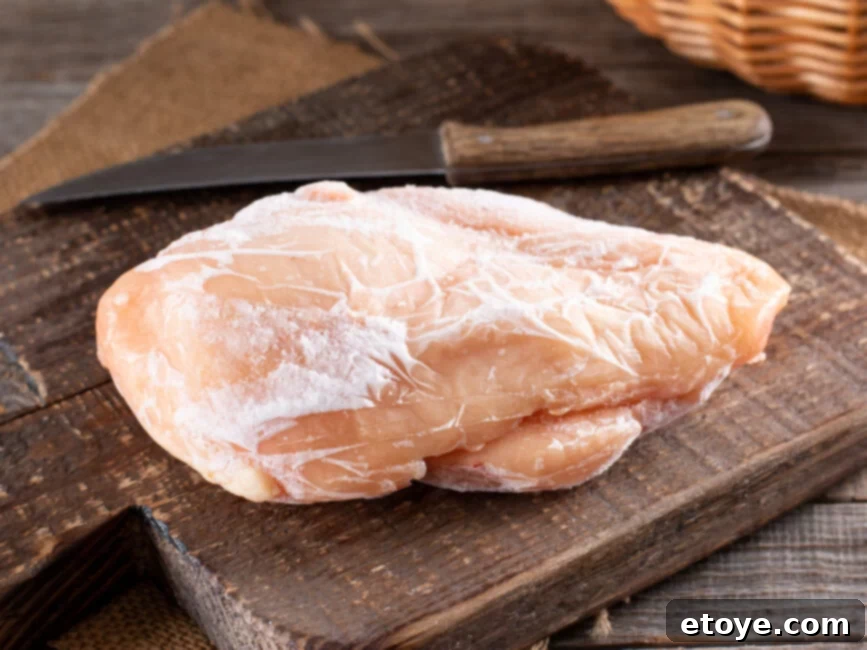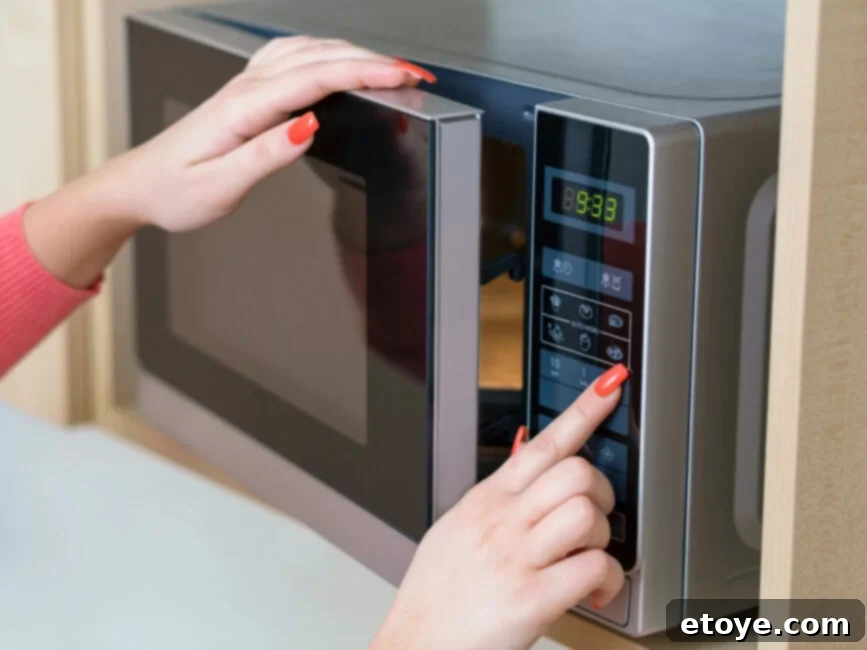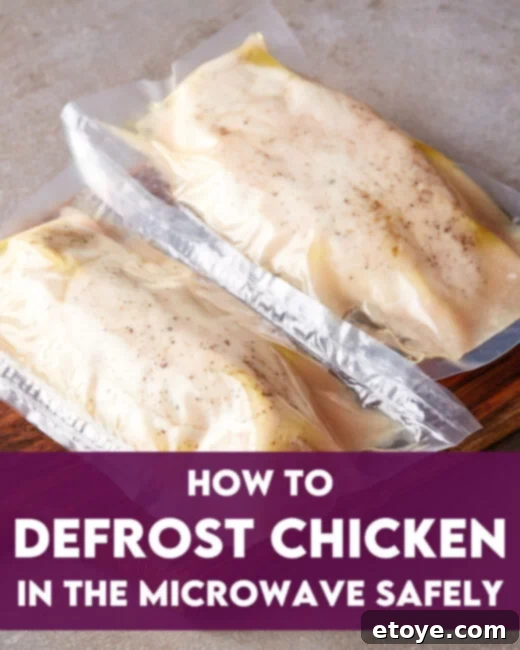Ever found yourself in a kitchen conundrum, staring down a rock-solid block of frozen chicken with dinner plans rapidly approaching? You’re certainly not alone! This common predicament has led countless home cooks to wonder about the quickest, most efficient way to get that chicken from icy to ready-to-cook. Often, the microwave comes to mind as a potential savior. But is defrosting chicken in the microwave a culinary shortcut or a fast-track to food safety issues? Let’s explore how to leverage your microwave safely and effectively, ensuring your last-minute meal preparations are both speedy and secure.

Unlocking the Power of Your Microwave: Can You Defrost Chicken?
The short answer is a resounding yes! Your microwave can be an invaluable tool for defrosting chicken, especially when time is of the essence. Most modern microwaves come equipped with a dedicated “defrost” setting designed specifically for this purpose. This intelligent function operates at a lower power level, often around 30-50% of the microwave’s full wattage, applying pulsed energy rather than continuous high heat. This controlled approach helps to gently raise the temperature of the frozen meat, bringing it to a safe range where it can be cooked without inadvertently cooking parts of it during the thawing process.
Whether you’re thawing a single chicken breast for a quick lunch salad, a few chicken thighs for a hearty evening stew, or a larger cut for a family dinner, the microwave’s defrost setting can drastically cut down on thawing time compared to traditional refrigerator methods. However, the convenience comes with a critical caveat: successful and safe microwave defrosting hinges entirely on proper technique. Failing to follow essential guidelines can quickly turn a time-saving hack into a significant food safety risk. Understanding these nuances is key to safely integrating microwave defrosting into your kitchen routine and ensuring your chicken is perfectly thawed and ready for its next culinary adventure.

Navigating the Risks: Essential Food Safety When Microwaving Chicken
While the microwave offers unparalleled speed, using it to defrost chicken requires a vigilant approach to food safety. The primary concern revolves around bacterial growth, which can lead to serious foodborne illnesses. Understanding and mitigating these risks is paramount for a safe meal.
Steering Clear of the Bacterial Danger Zone
The most critical concept to grasp is the “danger zone” for bacterial growth. This temperature range, specifically between 40°F (4°C) and 140°F (60°C), is where harmful bacteria like Salmonella and E. coli multiply most rapidly. When chicken thaws unevenly in a microwave – as can sometimes happen – some sections might warm up into this danger zone while others remain frozen. This creates a perfect breeding ground for bacteria, increasing the risk of food poisoning. The U.S. Department of Agriculture (USDA) strongly advises against leaving raw meat in this temperature range for extended periods.
The Perils of Uneven Thawing and Partial Cooking
A common issue with microwave defrosting is that the outer edges of the chicken can begin to cook while the center remains frozen. This not only results in an unpleasant texture (cooked exterior, raw interior) but also creates an environment ripe for bacterial proliferation. The “defrost” setting is designed to minimize this by cycling power, but constant vigilance and intervention from you are still necessary to ensure even thawing. Cooked or partially cooked spots can deceive you into thinking the entire piece is ready, leading to undercooked areas later.
The Golden Rule: Cook Immediately After Defrosting
Chicken defrosted in the microwave must be cooked immediately after thawing. This is not merely a recommendation; it’s a critical safety measure. Because microwave thawing can elevate parts of the chicken into the danger zone, cooking it right away is the only way to effectively destroy any bacteria that may have started to multiply. Do not refreeze raw chicken thawed in the microwave, nor should you allow it to sit at room temperature.
Never Thaw at Room Temperature
Resist the temptation to leave frozen chicken on the kitchen counter to thaw. While this might seem like a simple, hands-off approach, it is, in fact, one of the most dangerous methods. The outer layers of the chicken will quickly enter and remain in the danger zone for hours, allowing bacteria to flourish extensively before the interior even begins to thaw. This significantly increases the risk of foodborne illness, making it a practice to avoid at all costs.
Preventing Cross-Contamination
Beyond the chicken itself, consider your kitchen environment. Raw chicken juices can harbor bacteria. Always use microwave-safe dishes that can contain any drips, and thoroughly clean any surfaces, cutting boards, and utensils that come into contact with the raw chicken immediately after use. Wash your hands thoroughly with soap and warm water for at least 20 seconds before and after handling raw poultry to prevent the spread of bacteria.
By understanding these inherent risks and actively taking steps to mitigate them, you can leverage the speed of microwave defrosting without compromising the health and safety of your meals.

Your Step-by-Step Guide to Safely Defrosting Chicken in the Microwave
Defrosting chicken in the microwave requires more than just pushing a button; it’s a careful process that, when done correctly, ensures your poultry is perfectly thawed and safe for cooking. Follow these detailed steps to achieve optimal results:
Step 1: Choose the Right Container
- Opt for Microwave-Safe Materials: Always transfer your chicken from its original packaging to a microwave-safe dish. Glass or ceramic plates and bowls are ideal choices as they are non-reactive and won’t leach chemicals into your food.
- Avoid Harmful Plastics: Not all plastic containers are safe for microwave use. Look for labels indicating “microwave-safe” or the PP (polypropylene) symbol. Avoid using containers not explicitly designed for microwave heating, as they can release potentially harmful chemicals, such as BPA or phthalates, into your food, especially when heated. A good practice is to always err on the side of caution and use glass whenever possible.
Step 2: Prepare the Chicken for Defrosting
- Remove All Packaging: Before placing the chicken in the microwave, remove all original store packaging, including plastic wrap, trays, and absorbent pads. These materials are not designed for microwave use and can melt, catch fire, or leach chemicals.
- Separate Pieces (If Possible): If you have multiple pieces of chicken that are frozen together, try to separate them slightly before defrosting, or as soon as they become pliable. This promotes more even thawing. If you’re defrosting a whole chicken, ensure it fits comfortably in your microwave and container.
Step 3: Set Your Microwave Correctly
- Utilize the Defrost Setting: Most microwaves feature a dedicated “defrost” function. This setting typically operates at 20-50% power, cycling on and off to allow heat to penetrate without cooking the edges. If your microwave has a weight-based defrost option, enter the approximate weight of your chicken.
- Manual Power Adjustment: If your microwave lacks a specific defrost setting, you can manually set it to a low power level (e.g., 20-30% power) and use short bursts of time.
- Estimate Defrosting Time: As a general guideline, defrost chicken for approximately 8-10 minutes per pound. However, this can vary significantly based on your microwave’s wattage, the thickness of the chicken, and whether it’s bone-in or boneless. Always start with the lower end of the time estimate.
Step 4: Execute the Defrosting Process
- Position the Chicken: Arrange the chicken in a single layer in your microwave-safe dish. If defrosting larger or thicker pieces, position the thicker parts towards the outer edges of the dish, as microwaves tend to heat more intensely around the perimeter.
- Monitor and Flip Regularly: This is perhaps the most crucial step. Pause the microwave every 1-2 minutes to check on the chicken. Flip the pieces, rotate their position, and separate any parts that have started to thaw. This constant supervision helps ensure uniform thawing and prevents any section from overheating or beginning to cook. Break apart clumps of chicken as soon as they become pliable.
- Remove Thawed Portions: If some smaller pieces or thinner sections thaw completely before the rest, remove them from the microwave. This prevents them from starting to cook while the remaining chicken finishes thawing.
Step 5: Post-Defrosting Protocols
- Verify Complete Thawing: Once the microwave cycle is complete, carefully check the chicken for any remaining frozen spots or ice crystals. The chicken should feel flexible and cool, but not hard or icy in any area, especially in the thickest parts. If you find frozen spots, return it to the microwave for short, 30-second intervals on the defrost setting, checking frequently.
- Cook Immediately: This cannot be stressed enough: chicken defrosted in the microwave must be cooked immediately after thawing. The nature of microwave defrosting means that parts of the chicken may have entered the bacterial danger zone. Immediate cooking will bring the chicken to a safe internal temperature, eliminating any potential bacteria. Do not put microwave-thawed chicken back in the refrigerator or refreeze it uncooked.

Advanced Tips for Optimized Microwave Defrosting
To further enhance your microwave defrosting experience and ensure the best results, consider these additional tips:
- Cut Chicken into Smaller, Uniform Pieces: If your recipe allows, cutting larger cuts of chicken (like whole breasts or thighs) into smaller, more uniform pieces *before* freezing can significantly speed up the defrosting process. Smaller pieces thaw more evenly and quickly, reducing the risk of hot spots or partial cooking.
- Partially Defrost for Easier Preparation: Sometimes you don’t need the chicken fully thawed, but just soft enough to work with. Partially defrosting chicken in the microwave can make it much easier to slice into strips or cubes for stir-fries, fajitas, or skewers. Simply defrost for about half the recommended time, then slice while it’s still slightly firm.
- Cover with Microwave-Safe Wrap or Lid: While not strictly necessary, loosely covering your dish with microwave-safe plastic wrap or a lid can help retain moisture and promote more even heat distribution. Ensure the cover is vented to allow steam to escape. This also helps contain any splatters from chicken juices, keeping your microwave cleaner.
- Don’t Overload Your Microwave: Avoid stacking too many pieces of chicken at once. Overloading the microwave can lead to extremely uneven thawing, with some pieces still frozen solid while others are already partially cooked. Work in smaller batches if necessary.
- Clean Your Microwave Regularly: Juices from raw chicken can splatter during defrosting, even with careful handling. To prevent cross-contamination and maintain hygiene, wipe down the interior of your microwave with a sanitizing cleaner after defrosting raw meat.
Implementing these tips will not only make your microwave defrosting process more efficient but also safer, ensuring your chicken is always perfectly prepared for its next culinary step.
Beyond the Microwave: Exploring Alternative Defrosting Methods
While the microwave offers a rapid solution, it’s beneficial to know other methods for defrosting chicken, each with its own advantages and ideal scenarios. Having these alternatives in your culinary toolkit allows you to choose the safest and most convenient option based on your available time and specific needs.
The Refrigerator Method: Safest but Requires Planning
This is universally regarded as the safest method for defrosting chicken and all types of meat. It involves moving your frozen chicken from the freezer to the refrigerator, allowing it to thaw slowly at a consistent, cold temperature (below 40°F / 4°C). This keeps the chicken well out of the bacterial danger zone. The main drawback is the time commitment:
- Timeframe: A pound of boneless chicken breasts or thighs can take approximately 24 hours to thaw. A larger whole chicken, such as a 5-pound bird, might require up to two full days.
- Procedure: Place the frozen chicken, still in its original sealed packaging or transferred to a leak-proof plastic bag, onto a plate or in a container. This prevents any potential drips from contaminating other foods in your fridge. Position it on the lowest shelf of your refrigerator to minimize contamination risk.
- Advantage: The greatest benefit of refrigerator thawing is safety and flexibility. Once thawed, chicken can remain safely in the refrigerator for an additional 1-2 days before cooking. You can also refreeze chicken thawed by this method, as long as it has not been left out for more than 48 hours.
The Cold Water Bath Method: Faster Than the Fridge, Needs Attention
When you’re short on time but prefer not to use the microwave, the cold water method is an excellent compromise. It’s faster than refrigerator thawing but requires more active supervision.
- Timeframe: A 1-pound package of chicken can thaw in about an hour, while a 3-4 pound whole chicken might take 2-3 hours.
- Procedure: First, ensure your chicken is in a completely airtight, leak-proof bag (e.g., a heavy-duty zip-top bag, double-bagged if necessary). This prevents water from seeping in and contaminating the chicken or diluting its flavor. Submerge the sealed bag in a large bowl or sink filled with cold tap water.
- Critical Step: Change the cold water every 30 minutes. This is crucial because stagnant water will gradually warm up, allowing the chicken to enter the danger zone. Changing the water maintains a consistently cold environment around the chicken, promoting safe and efficient thawing.
- Advantage: This method significantly reduces thawing time compared to the refrigerator. Like microwave-thawed chicken, chicken thawed using the cold water method should be cooked immediately after it’s fully defrosted.
Cooking from Frozen: A Direct Approach
For certain dishes and cuts, you can even cook chicken directly from its frozen state. This is not a defrosting method, but a cooking strategy. While it typically increases cooking time by about 50%, it eliminates the need for prior thawing altogether. This method is best suited for recipes like baked chicken breasts, stews, or slow-cooker dishes. However, it’s not ideal for quick-cooking methods where even browning and internal temperature control are critical, such as pan-frying or grilling, as the exterior may overcook while the interior is still undercooked.
By understanding these different approaches, you can confidently choose the best method for your specific needs, always prioritizing food safety above all else.

Frequently Asked Questions About Defrosting Chicken in the Microwave
To further clarify the process and address common concerns, here are answers to some of the most frequently asked questions regarding microwave chicken defrosting.
Can you refreeze chicken that has been defrosted in the microwave?
No, not raw chicken. If chicken was thawed in the microwave, it should be cooked immediately and then, if desired, the cooked chicken can be refrozen. Refreezing raw chicken that was thawed in the microwave is strongly discouraged because parts of the chicken may have warmed up into the “danger zone” during thawing, encouraging rapid bacterial growth. Cooking it first kills these bacteria. In contrast, chicken thawed safely in the refrigerator can be refrozen raw within 1-2 days of thawing, provided it has been kept continuously cold.
How long does it take to defrost chicken in the microwave?
The defrosting time for chicken in the microwave typically ranges from 8 to 10 minutes per pound on the defrost setting. However, this is just a general guideline. Factors like your microwave’s wattage, the thickness and density of the chicken pieces, and whether they are bone-in or boneless will affect the actual time. It’s crucial to check the chicken regularly (every 1-2 minutes) and flip/rotate it to ensure even thawing. Always aim to defrost for the minimum necessary time.
What do you do if the edges of the chicken start to cook while you’re defrosting?
If you notice the edges of your chicken beginning to cook or turn white/opaque while defrosting, immediately stop the microwave cycle. Remove the chicken, and if possible, separate the partially cooked pieces. Allow the chicken to rest for a few minutes to redistribute any residual heat. You can then continue defrosting at an even lower power level (e.g., 20% power) for very short intervals (30 seconds), or use the cold water method for the remainder of the thawing process. Rotating the chicken and breaking apart pieces more frequently can also help prevent this issue.
Can I defrost a whole chicken in the microwave?
While technically possible, defrosting a whole chicken in the microwave is generally not recommended by food safety experts. Whole chickens are very dense and unevenly shaped, making it exceedingly difficult to achieve uniform thawing in a microwave. The outer layers and thinner parts will almost certainly begin to cook well before the interior is fully thawed, creating a significant food safety risk due to uneven heating and potential bacterial growth in the still-cold center. For whole chickens, the refrigerator method is always the safest and most reliable choice, or the cold water bath if you’re pressed for time.
What if my microwave doesn’t have a specific defrost setting?
If your microwave lacks a dedicated “defrost” function, you can still safely thaw chicken by using a manual power setting. Set your microwave to a low power level, typically 20-30% of its full power. Then, defrost the chicken in very short intervals (e.g., 30-60 seconds), checking and flipping/rotating the chicken frequently. This mimics the pulsed power action of a dedicated defrost setting. Be extra vigilant to ensure the chicken doesn’t start cooking and that all parts thaw evenly.
How do I know my chicken is thawed but not cooked?
A properly thawed chicken should be cold and pliable throughout, with no hard, icy spots or ice crystals. It should feel flexible to the touch, and you should be able to press into the flesh slightly. Crucially, there should be no opaque white areas (indicating cooking) on the surface or edges. If you see any signs of cooking, stop the defrosting process. The goal is to bring the chicken just to a thawed state, ready for immediate cooking, not to begin the cooking process itself.

Now You Know: Mastering Microwave Chicken Defrosting!
Defrosting chicken in the microwave truly can be a culinary game-changer, especially during those hectic moments when dinner needs to be on the table sooner rather than later. It offers a speed and convenience that other methods simply can’t match. However, the key to harnessing this power safely lies in understanding and diligently following the proper techniques. From selecting the right microwave-safe containers to utilizing your defrost setting correctly, monitoring the process closely, and most importantly, cooking the chicken immediately after thawing, every step plays a vital role in preventing bacterial growth and ensuring food safety.
By integrating these expert tips and best practices into your kitchen routine, you can confidently and effectively thaw your chicken in the microwave, making your meal preparation faster, safer, and ultimately more enjoyable. So next time you find yourself facing a frozen chicken dilemma, remember these guidelines and transform that icy block into a delicious, ready-to-cook meal without a moment’s hesitation!
We’d love to hear from you! Have you tried defrosting chicken in the microwave? Do you have any personal tips or experiences to share that help ensure safe and effective thawing? Drop your thoughts, questions, and insights in the comments below – your advice could help fellow home cooks!
Looking for Other Essential Kitchen & Food Answers?
- How Long Does Ground Sausage Last In The Fridge?
- How Long Does Tea Last in the Fridge Before it Goes Bad?
- How Long Does Lunch Meat Last in the Fridge?
